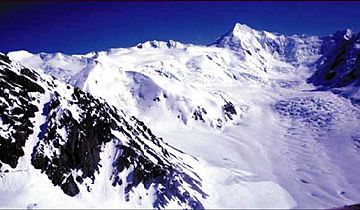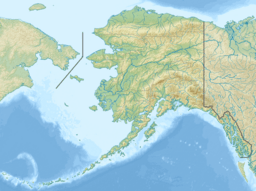Hayes Volcano facts for kids
Quick facts for kids Hayes Volcano |
|
|---|---|

Hayes Volcano, 1981
|
|
| Highest point | |
| Elevation | 9,147 ft (2,788 m) |
| Listing | List of volcanoes in the United States |
| Geography | |
| Location | Matanuska-Susitna Borough, Alaska |
| Parent range | Tordrillo Mountains |
| Topo map | USGS Tyonek C-7 |
| Geology | |
| Mountain type | Stratovolcano |
| Volcanic arc/belt | Aleutian Arc |
| Last eruption | 1200 ± 300 years |
Hayes Volcano is a huge, cone-shaped volcano called a stratovolcano. It is found in southwestern Matanuska-Susitna Borough, Alaska, about 135 kilometers (84 miles) northwest of Anchorage. What's cool is that this volcano wasn't even known until 1975!
Hayes Volcano is famous for creating six big layers of volcanic ash and rock, called tephra, in the Cook Inlet area of Alaska. This volcano was mostly destroyed by at least six massive eruptions between 3,400 and 3,800 years ago. Each of these eruptions was super powerful, averaging about 2.4 cubic kilometers of material. To give you an idea, the famous 1980 eruption of Mount St. Helens was about 1 cubic kilometer. This means Hayes Volcano's eruptions were some of the biggest in the Cook Inlet region during the Holocene period (the last 11,700 years).
Today, there is no steam or gas coming out of the volcano. The last time Hayes Volcano erupted was about 1,200 years ago. It gets its name from the Hayes Glacier, which is right next to it.
Contents
What Hayes Volcano Looks Like
Hayes Volcano is mostly covered in ice and glaciers. It's an eruptive center from the Quaternary period, which means it's relatively young in geological terms. The volcano is made up of different volcanic materials. These include pyroclastic deposits (bits of rock and ash shot out during eruptions), volcanic breccia (sharp, broken rock pieces cemented together), and lava domes (mounds formed by slow-moving lava).
Even though most of the volcano is hidden by ice, you can see parts of small lava domes and volcanic debris sticking out. These parts are visible at heights of 2,400 to 2,800 meters (about 7,900 to 9,200 feet) above sea level.
Location in the Tordrillo Mountains
Hayes Volcano is nestled within the Tordrillo Mountains. This mountain range is very rugged and covered in glaciers. It sits between the Alaska Range and Cook Inlet. The mountains are mostly made of older igneous rocks, which are rocks formed from cooled magma.
Most of this area is very high, more than 1,500 meters (about 4,900 feet) tall. It has a huge system of glaciers and snow that covers most of the mountains. We don't know exactly how much ice and snow is on Hayes Volcano. However, it's thought to be similar to Mount Spurr volcano, which has about 67 cubic kilometers (16 cubic miles) of ice and snow.
How Hayes Volcano is Different
Hayes Volcano is unique compared to other volcanoes in the Cook Inlet area. It doesn't have a clear, cone-shaped peak like many volcanoes do. Also, we haven't found any eruption deposits older than 4,400 to 3,600 years ago.
Most other volcanoes in the Cook Inlet region have huge amounts of volcanic rock and debris. These volcanoes have been forming over many tens of thousands of years. Hayes Volcano is different because its current shape is mostly from more recent, very powerful eruptions.
Has Hayes Volcano Erupted Recently?
We don't know of any eruptions from Hayes Volcano in recorded history. There are also no clear signs of recent volcanic activity on the volcano itself.
Scientists visited the volcano in 1999 and 2000. They didn't see any signs of volcanic unrest. This means there was no melting glacier ice, no steam coming out, and no ash discoloring the ice surface. This suggests the volcano has been quiet for a long time.


